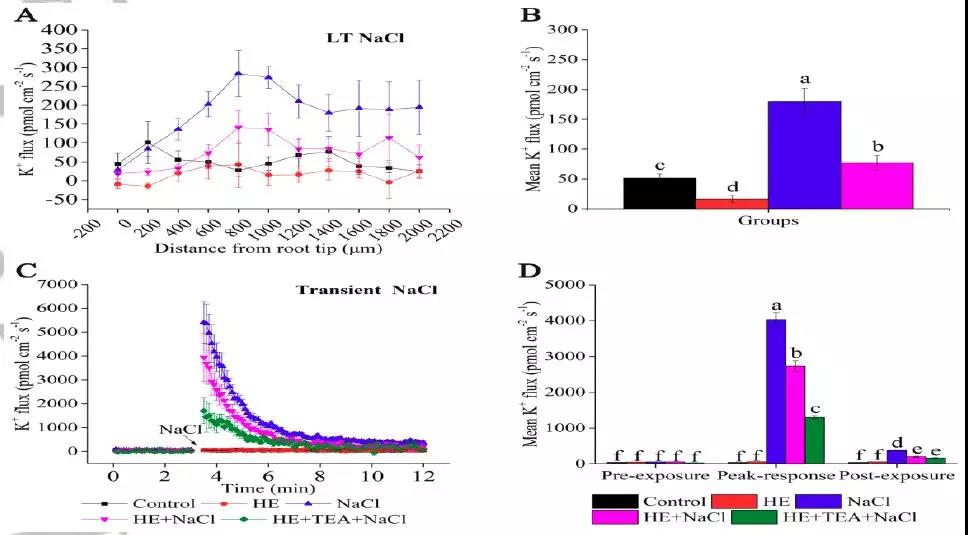NMT是基因功能的活体检测技术,已被103位诺贝尔奖得主所在单位,及北大、清华、中科院使用。
期刊:Plant Cell & Environment
主题:沙冬青虫害/盐害交互抗性机制研究
标题:Herbivore exposure alters ion fluxes and improves salt tolerance in a desert shrub
影响因子:6.125
检测指标:Ca2+、K+、Na+、H+流速
检测样品:矮沙冬青
作者:北京林业大学沈应柏、陈迎迎
文章简介
沙冬青是西北荒漠唯一的常绿阔叶灌木,是第三纪孑遗植物,国家二级濒危物种。沙冬青生境极其恶劣,常伴随着极端温度、干旱、盐碱、虫害,但目前关于沙冬青生物与非生物交互抗性的研究甚少。因此,沈应柏教授研究团队利用非损伤微测、激光共聚焦等技术,系统研究了经昆虫取食的沙冬青在遭受盐胁迫时的根部离子跨膜转运模式。该研究发现,昆虫取食预处理可能通过激活OPR3活性诱导茉莉酸的积累,茉莉酸信号途径的激活诱导了胞内Ca2+的迅速积累,增强了质膜H+-ATPase活性,促进了胞内过多的Na+经由Na+/H+逆向转运体的外排,同时抑制K+的流失,有助于维持细胞内的K+/Na+平衡,最终增强沙冬青的耐盐性。
博士研究生陈迎迎为该论文第一作者,沈应柏教授为通讯作者。该研究相关工作得到国家自然科学基金项目(31270655)的资助。
英文摘要
Plants have evolved complex mechanisms that allow them to withstand multiple environmental stresses, including biotic and abiotic stresses.
Here, we investigated the interaction between herbivore exposure and salt stress of Ammopiptanthus nanus, a desert shrub. We found that jasmonic acid (JA) was involved in plant responses to both herbivore attack and salt stress, leading to an increased NaCl stress tolerance for herbivore-pretreated plants, and increase in K+/Na+ ratio in roots. Further evidence revealed the mechanism by which herbivore improved plant NaCl tolerance. Herbivore pretreatment reduced K+ efflux and increased Na+ efflux in plants subjected to long-term, short-term, or transient NaCl stress.
Moreover, herbivore pretreatment promoted H+ efflux by increasing plasma membrane H+-ATPase activity. This H+ efflux creates a transmembrane proton motive force that drives the Na+/H+ antiporter to expel excess Na+ into the external medium. In addition, high cytosolic Ca2+ was observed in the roots of herbivore-treated plants exposed to NaCl, and this effect may be regulated by H+-ATPase.
Taken together, herbivore exposure enhances A. nanus tolerance to salt stress by activating the JA signalling pathway, increasing plasma membrane H+-ATPase activity, promoting cytosolic Ca2+ accumulation, and then restricting K+ leakage and reducing Na+ accumulation in the cytosol.
中文摘要(谷歌机翻)
植物已经进化出复杂的机制,可以承受多种环境胁迫,包括生物和非生物胁迫。
在这里,我们调查了草食动物暴露与沙漠灌木沙冬青盐胁迫之间的相互作用。我们发现茉莉酸(JA)参与了植物对食草动物侵袭和盐胁迫的反应,导致食草动物预处理过的植物对NaCl胁迫的耐受性增加,并且根中K+ / Na+比率增加。进一步的证据揭示了草食动物改善植物NaCl耐受性的机制。草食动物预处理可降低长期,短期或短暂NaCl胁迫下植物的K+流出量并增加Na +流出量。
此外,草食动物预处理通过增加质膜H+ -ATPase活性来促进H +流出。这种H+外流产生跨膜质子原动力,该原动力驱动Na+ / H+反向转运蛋白将过量的Na+排出到外部介质中。此外,在暴露于NaCl的食草动物处理过的植物的根部中观察到高的胞质Ca2+,这种作用可能受H+ -ATPase调节。
总之,通过激活JA信号传导途径,增加质膜H+ -ATPase活性,促进胞质Ca2 +积累,然后限制K+泄漏并减少细胞质中Na +的积累,草食动物暴露增强了南芥对盐胁迫的耐受性。

Figure 2. Effects of NaCl on the stable and transient flux of K+ along the A. nanus root axis (from 0 to 2000 μm from the root apex) with or without herbivore pretreatment. (A) The stable K+ flux was recorded along the axis of the root apex (0~2000 μm from the root tip) at 200-μm intervals, after long-term (LT) combined stresses (24-h HE + 7-d NaCl), salt stress (7-d NaCl), or no stress (control). (B) The bar chart represents the mean K+ flux value of all points along the roots following the four treatments. (C) The transient K+ flux kinetics were measured at the surface of the root, 600 μm from the tip, before and after the application of 100 mM NaCl. Three minutes of baseline data were recorded before NaCl application. The arrow indicates the time point of NaCl addition. Ten minutes of data were recorded after NaCl application. Samples were pretreated with tetraethylammonium (TEA), a K+ channel blocker, for 30 min before test. (D) The mean K+ flux was calculated before (pre-exposure), immediately after (peak-response), and 10 min after (post-exposure) the NaCl treatment. Different letters indicate significant differences at P ≤ 0.05 (Student’s t-test). Data were obtained from 5–7 A. nanus individuals. Error bars represent SE.
文章链接:
